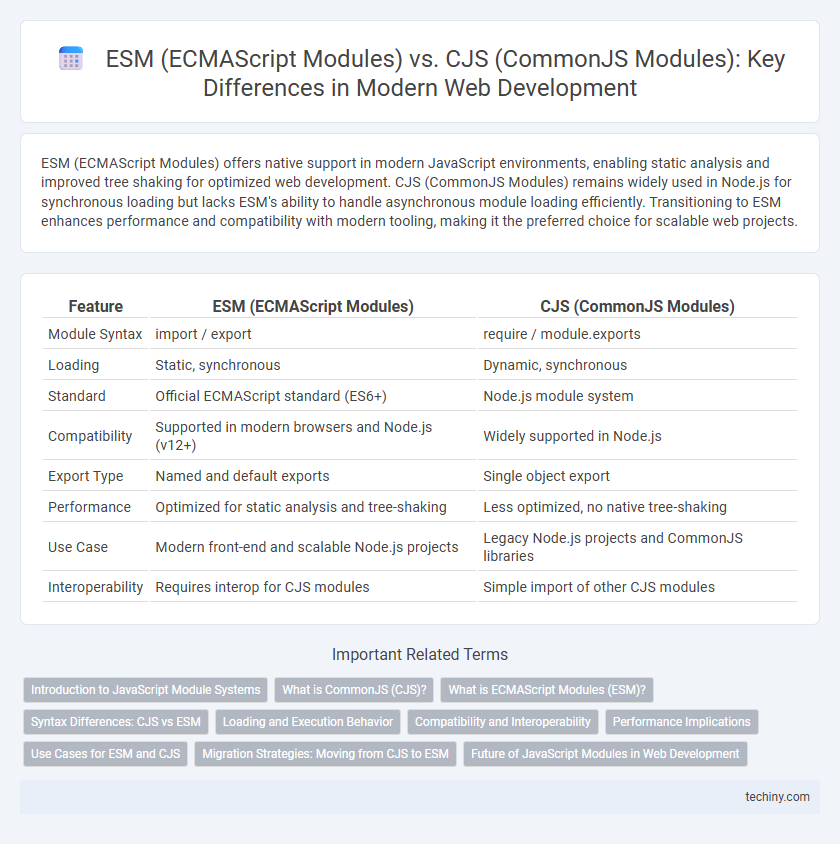ESM (ECMAScript Modules) offers native support in modern JavaScript environments, enabling static analysis and improved tree shaking for optimized web development. CJS (CommonJS Modules) remains widely used in Node.js for synchronous loading but lacks ESM's ability to handle asynchronous module loading efficiently. Transitioning to ESM enhances performance and compatibility with modern tooling, making it the preferred choice for scalable web projects.
Table of Comparison
| Feature | ESM (ECMAScript Modules) | CJS (CommonJS Modules) |
|---|---|---|
| Module Syntax | import / export | require / module.exports |
| Loading | Static, synchronous | Dynamic, synchronous |
| Standard | Official ECMAScript standard (ES6+) | Node.js module system |
| Compatibility | Supported in modern browsers and Node.js (v12+) | Widely supported in Node.js |
| Export Type | Named and default exports | Single object export |
| Performance | Optimized for static analysis and tree-shaking | Less optimized, no native tree-shaking |
| Use Case | Modern front-end and scalable Node.js projects | Legacy Node.js projects and CommonJS libraries |
| Interoperability | Requires interop for CJS modules | Simple import of other CJS modules |
Introduction to JavaScript Module Systems
JavaScript module systems primarily include ECMAScript Modules (ESM) and CommonJS (CJS), which organize and reuse code efficiently across projects. ESM supports static analysis, enabling features like tree shaking for optimized bundle sizes, and is standardized for native browser support since ES6. CommonJS, mainly used in Node.js, loads modules synchronously and dynamically, making it ideal for server-side applications but less efficient in browser environments.
What is CommonJS (CJS)?
CommonJS (CJS) is a module system widely used in Node.js that enables the inclusion and export of functionalities using synchronous require() calls. It organizes JavaScript code into modules by creating isolated scopes, promoting reusable and maintainable code structures. Unlike ECMAScript Modules (ESM), CJS operates primarily on the server side and uses module.exports and require() for module interaction.
What is ECMAScript Modules (ESM)?
ECMAScript Modules (ESM) are the standardized module system in JavaScript designed for better interoperability and static analysis, enabling improved tree shaking and faster parsing in modern browsers. ESM uses explicit `import` and `export` statements to define dependencies and expose module contents, supporting asynchronous loading and scope isolation. Unlike CommonJS, ESM is natively supported in browsers and modern JavaScript environments, promoting more efficient and maintainable code structures.
Syntax Differences: CJS vs ESM
ECMAScript Modules (ESM) use import and export statements, enabling static analysis and tree-shaking, while CommonJS (CJS) relies on require and module.exports, which operate dynamically at runtime. ESM supports asynchronous module loading with top-level await, contrasting with the synchronous loading in CJS. The static syntax of ESM improves optimization and tooling compatibility, whereas CJS syntax allows conditional and dynamic module loading within Node.js environments.
Loading and Execution Behavior
ESM (ECMAScript Modules) use static loading with import/export statements that allow for compile-time analysis and tree-shaking, enabling efficient bundling and faster execution. CommonJS modules rely on dynamic loading with require(), executing modules synchronously and caching the exports after the first load, which can lead to slower startup in larger applications. ESM supports asynchronous loading and better optimization in modern browsers and Node.js environments, while CJS remains widely used for synchronous module resolution in legacy systems.
Compatibility and Interoperability
ESM (ECMAScript Modules) offers native support in modern JavaScript environments, ensuring seamless compatibility with browser-based applications and enabling efficient static analysis and tree-shaking. CommonJS (CJS) remains widely used in Node.js for synchronous module loading and legacy codebases but faces challenges when interoperating with ESM due to differing module resolution and export/import semantics. Bridging interoperability requires tools like Babel or dynamic import strategies, but gradual migration to ESM improves cross-environment compatibility and future-proofs modern web development workflows.
Performance Implications
ESM (ECMAScript Modules) offer improved performance in modern JavaScript environments due to static analysis capabilities that enable better tree-shaking and faster module loading compared to CJS (CommonJS Modules), which rely on synchronous loading. In server-side applications, ESM's asynchronous loading contributes to non-blocking I/O operations, enhancing scalability and responsiveness. Although CJS modules have widespread support and simpler interoperability, the inherent synchronous nature can lead to performance bottlenecks in large-scale applications.
Use Cases for ESM and CJS
ESM (ECMAScript Modules) excels in modern web development environments requiring native browser support and efficient tree-shaking for optimized bundle sizes. CJS (CommonJS Modules) remains prevalent in Node.js applications where synchronous module loading and compatibility with older tooling are critical. Use ESM for frontend projects leveraging ES6+ features and CJS for backend systems dependent on legacy Node.js ecosystem libraries.
Migration Strategies: Moving from CJS to ESM
Migrating from CommonJS (CJS) to ECMAScript Modules (ESM) requires incremental codebase updates, starting with enabling `"type": "module"` in package.json to activate ESM support. Using dynamic `import()` allows asynchronous loading of ESM modules within CJS files, facilitating gradual refactoring without breaking the application. Tools like `esm-loader` and transpilers such as Babel help bridge compatibility gaps, ensuring smooth interoperability during the transition process.
Future of JavaScript Modules in Web Development
ESM (ECMAScript Modules) is rapidly becoming the standard for JavaScript module management due to its native browser support, improved static analysis, and better tree-shaking capabilities, which optimize performance and reduce bundle sizes. Unlike CommonJS (CJS), which is primarily designed for server-side environments and relies on synchronous loading, ESM supports asynchronous module loading, making it ideal for modern, client-side web applications. The future of JavaScript modules in web development leans heavily towards ESM adoption, driven by its compatibility with native JavaScript specifications and growing ecosystem support across both frontend and backend platforms.
ESM (ECMAScript Modules) vs CJS (CommonJS Modules) Infographic

 techiny.com
techiny.com